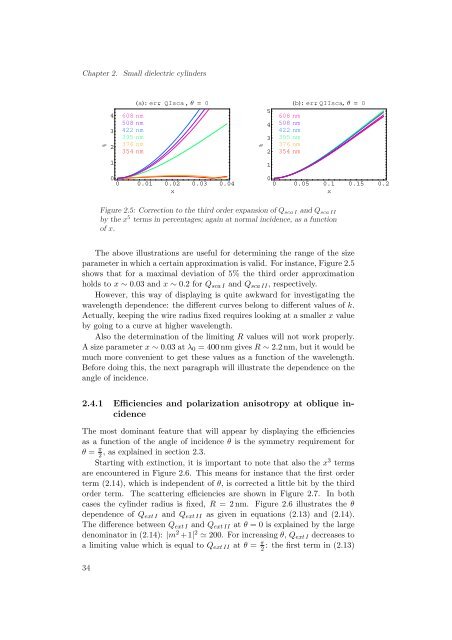Optical properties of cylindrical nanowires
Optical properties of cylindrical nanowires
Optical properties of cylindrical nanowires
Create successful ePaper yourself
Turn your PDF publications into a flip-book with our unique Google optimized e-Paper software.
Chapter 2.Small dielectric cylinders%432608 nm508 nm422 nm395 nm376 nm354 nma:err. QIsca,Θ ⩵ 0%5432608 nm508 nm422 nm395 nm376 nm354 nmb:err.QIIsca,Θ ⩵ 01100 0.01 0.02 0.03 0.04x00 0.05 0.1 0.15 0.2xFigure 2.5: Correction to the third order expansion <strong>of</strong> Q sca I and Q sca IIby the x 5 terms in percentages; again at normal incidence, as a function<strong>of</strong> x.The above illustrations are useful for determining the range <strong>of</strong> the sizeparameter in which a certain approximation is valid. For instance, Figure 2.5shows that for a maximal deviation <strong>of</strong> 5% the third order approximationholds to x ∼ 0.03 and x ∼ 0.2 for Q sca I and Q sca II , respectively.However, this way <strong>of</strong> displaying is quite awkward for investigating thewavelength dependence: the different curves belong to different values <strong>of</strong> k.Actually, keeping the wire radius fixed requires looking at a smaller x valueby going to a curve at higher wavelength.Also the determination <strong>of</strong> the limiting R values will not work properly.A size parameter x ∼ 0.03 at λ 0 = 400 nm gives R ∼ 2.2 nm, but it would bemuch more convenient to get these values as a function <strong>of</strong> the wavelength.Before doing this, the next paragraph will illustrate the dependence on theangle <strong>of</strong> incidence.2.4.1 Efficiencies and polarization anisotropy at oblique incidenceThe most dominant feature that will appear by displaying the efficienciesas a function <strong>of</strong> the angle <strong>of</strong> incidence θ is the symmetry requirement forθ = π 2, as explained in section 2.3.Starting with extinction, it is important to note that also the x 3 termsare encountered in Figure 2.6. This means for instance that the first orderterm (2.14), which is independent <strong>of</strong> θ, is corrected a little bit by the thirdorder term. The scattering efficiencies are shown in Figure 2.7. In bothcases the cylinder radius is fixed, R = 2 nm. Figure 2.6 illustrates the θdependence <strong>of</strong> Q ext I and Q ext II as given in equations (2.13) and (2.14).The difference between Q ext I and Q ext II at θ = 0 is explained by the largedenominator in (2.14): |m 2 +1| 2 ≃ 200. For increasing θ, Q ext I decreases toa limiting value which is equal to Q ext II at θ = π 2: the first term in (2.13)34
















